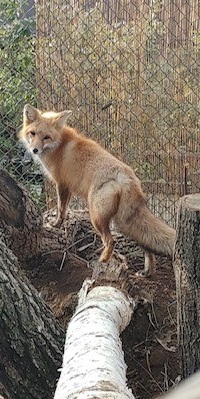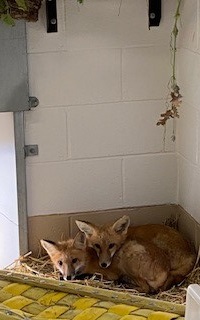Eastern red fox
Vulpes vulpes
- Habitat: Forest, Shrubland, Grassland, Wetlands (inland), Desert
- Range: Across Canada and the U.S.A east of the Rocky mountains
- Natural Diet: Small mammals, birds, fish, insects, plants, fruits, and berries.
- Status in the Wild: Common
All about the Red Fox
The Red Fox is the largest of the foxes and it belongs to the dog family Canidae. The reddish-brown coloring of their thick fur gives them their name. They have short stubby legs that are black and long bodies with distinctive white-tipped black tails. They have long, slender, pointed snouts that are white with dark brown or black noses and long pointed black ears. Since they are ground-dwelling, their reddish-brown fur and white underbelly help camouflage them and hide from prey. They are about three feet long and about 1.5 feet tall. Their tails are 1.5 feet in length. Male and female Red Foxes are monomorphous and are very similar in coloring, shape, and form.
Diet/ Habitat/ Range
Red Foxes are found across Europe, Asia, and northern Africa. They have also been introduced to Australia and North America.
They are omnivorous feeding on fruits, invertebrates, reptiles, small birds, and small mammals and also on grasses, tubers, nuts, acorns, corn, wheat, and sedges.
Behavior
Red Foxes are either active around dawn and dusk (crepuscular) or only active at night (nocturnal). Since they are active by night, their large eyes and vertically positioned ears help them hunt and navigate. Their advanced senses of sight and hearing help increase their hunting success. Unlike wolves, they are solitary by nature pairing only during the breeding season. Both males and females maintain territories within which, they hunt and feed, rest, and have young. A territory is usually occupied by a single adult male and two or more females and their young. They scent-mark their territorial boundaries with urine. They dig dens in the form of burrows in which they rest and raise their young.
Like wolves, Red Foxes use a range of vocalizations to communicate with their family and with their competitors. The most common vocalizations are the contact call, the interaction call, and the alarm call. The contact call sounds like a howl often emitted by kits when they are looking for their mother. An interaction call is emitted when two unknown adults meet. This is a whining sound and is often emitted by the submissive animal while the dominant animal emits a bark. Barks are also emitted by foxes as alarm calls to alert their families to the presence of a predator. Chuffing is another type of interactional call emitted often by a mother when she is interacting with her young.
Reproduction
Female Red Foxes partner with a single male but are also known to breed with several males. Breeding takes place during the winter and spring months during which young are born. A litter size usually consists of five kits although some litters are known to consist of 8 to 9 kits. Female foxes take care of their young while males defend their territories to protect their females and young from predators and competition. Females nurse their young for the first two to 2.5 months of their lives after which they are weaned. Kits stay with their mothers until they sexually mature which is around 10 months after which, they disperse. During these months, females train their young, to hunt and feed, hide from predators, protect their territories, and protect their young.
Conservation/Status
Although Red Foxes face threats from habitat degradation, illegal hunting, and trapping, the International Union for the Conservation of Nature (IUCN) have assessed their free-ranging populations to be stable and unaffected by these pressures and has categorized them as Least Concern.



